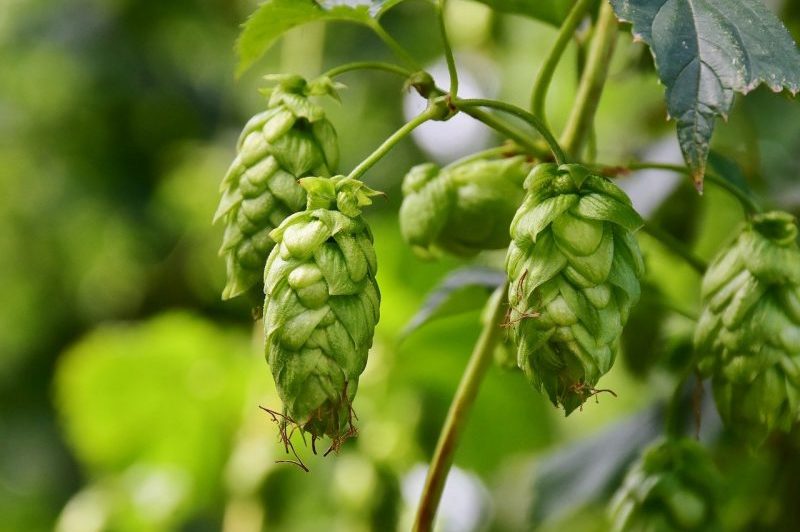Before you try to figure out how to grow hops in Michigan, you need to gain a deeper understanding of the plant itself. Read on to learn more about this plant.

A Closer Look at Hops
These are perennials that feature twining stems or bines from the permanent rootstock during springtime. Since hop plants are known to be dioecious, separate plants grow to make and female flowers or cones. In commercial hopyards, stout hairs or trichomes are used to help the hop plants as they grow in a clockwise manner around trellis systems.
The right conditions enable bines to grow up to 4 to 10 inches per day. In late June, during the summer solstice, hop plants tend to grow lateral branches. During this time, they also produce clusters of green cones or flowers.
Keep in mind that only the cones and flowers produced by the female hop plants are used in the process of brewing beer.
Although hop plants can be grown in various areas, their origins can be traced back to China. In the United States, the commercial production of this plant started in the 1700s on the East Coast. Nowadays, over 80% of the country’s hops are grown in the Pacific Northwest.
Since locally-grown food and specialty beers are becoming more and more popular these days, the production of hops significantly increased among gardening enthusiasts, farmers, as well as homebrewers in Michigan.
The Different Uses of Hops
Throughout history, these flowers are known for their medicinal properties. Hops can be used as a sleep aid in your pillows and a perfect addition to your salad.
However, when it comes to beer production, hops are used as a flavoring agent, as well as a preservative. Thanks to its essential oils and alpha and beta acids, hops provide beer with its characteristic bitterness and aroma. During the various stages of beer’s brewing process, different varieties of hops are added until the desired taste and aroma is achieved.
Tips on How to Grow Hops in Michigan
To give you an idea about how you can grow hops in Michigan, check out these useful tips:
Tip #1: Choose the right kind of soil
Hop plants won’t have any trouble growing in different types of soils. However, they thrive well when they’re planted in well-drained loam soils that are deep and sandy.
The ideal pH for hop plant growth is around 6.5. If you’re siting hop yards, make sure that you avoid doing so in heavy soil that’s poorly-drained.
Tip #2: Determine the growing season
In order to produce high cone yields, hops plants require a growing season that has longer days and shorter nights. Additionally, they also need about one to two months of winter temperatures that go below 40˚F. This explains why the commercial production of hop plants occur between 40˚F and 50˚ latitude.
Tip #3: Provide supplemental water and nutrients
Hop plants require supplemental water, as well as nutrients in order to fully develop and thrive well.
Does Greenhouse Gardening Make Perfect Sense?
Compared to traditional outdoor gardening, greenhouse gardening offers more benefits. You’d be doing yourself and your plants a big favor if you set up your own semi pro or hobby greenhouse.
Although this may initially entail a huge investment, you won’t be disappointed with the rewards you’ll reap. To prove this point, here’s a look at the amazing benefits of greenhouse gardening:
You can control your plants’ growing conditions
Setting up your very own greenhouse gives you the opportunity to manipulate the growing conditions of your precious plants. The enclosed space allows you to easily control the temperature, as well as the humidity levels in order to encourage plant growth.
It offers protection against harsh weather conditions
While traditional outdoor gardening is great, it won’t be able to guarantee your plants’ safety in the event of harsh weather conditions. For this reason, those who garden outdoors are required to make emergency preparations before the storm sets in. On the other hand, a greenhouse eliminates the need for such preparations because the structure itself provides your plants with a layer of protection against the elements.
It keeps your plants safe from pests and vermin
One of the worst things that can happen to your plant babies is a pest infestation and vermin attack. These are constant threats that traditional outdoor gardeners face. When these insects and animals find their way into their gardens, they cause irreversible damage to the plants.
However, with a greenhouse to act as a barrier, you can be sure that vermin and harmful insects will be kept at bay.
You can grow your own food
Having your own greenhouse makes it easier for you to plant and grow your favorite vegetables, fruits, and herbs. Since greenhouse gardening enables you to grow your own food, you’ll get to save money on grocery shopping. What’s more, you can also be sure that no harmful chemicals were used to grow your crops.
You can extend growing seasons
Growing seasons can be extended if you grow your plants inside a greenhouse. Since their growing conditions can be easily manipulated, greenhouse gardening makes it possible for you to grow plants that aren’t native to your region.
Conclusion
Now that you’ve finally figured out how to grow hops in Michigan, you may want to consider growing them in a greenhouse!
